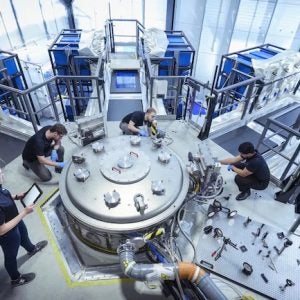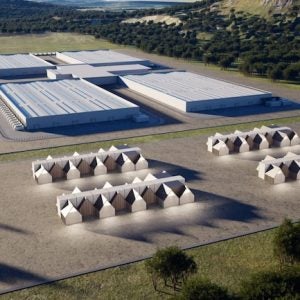
Above: Kakhovka dam before and after collapse
“Today the Nova Kakhovka dam was severely damaged leading to a significant reduction in the level of the reservoir used to supply cooling water to the Zaporizhia NPP (ZNPP),” International Atomic energy Agency (IAEA) Director General Rafael Mariano Grossi told the IAEA Board of Governors (BOG) on 6 June.
He said the water is required for the essential cooling water system which provides cooling (among other) to the following:
- residual heat removal from the reactors (spent or partially spent fuel there);
- residual heat removal from the spent fuel ponds; and
- cooling of the emergency diesel generators (when they are running).
“Absence of cooling water in the essential cooling water systems for an extended period of time would cause fuel melt and inoperability of the emergency diesel generators. However, our current assessment is that there is no immediate risk to the safety of the plant.”
Since Russia took control of ZNPP in March 2022 as part of its special military operation in Ukraine, the Russian national guard has been protecting the station and in October, Russian President Vladimir Putin signed a decree formally transferring ZNPP to Russian jurisdiction under nuclear utility Rosenergoatom (part of Rosatom). A Russian Federal State Unitary Enterprise. Zaporizhia NPP was established by Rosenergoatom to operate the plant. However, Ukrainian nuclear utility Energoatom still claims ownership of the plant. IAEA has had experts permanent stationed at the plant – the Support & Assistance Mission to Zaporizhia (ISAMZ).
Reports by Russian military analysts suggest that retaking control of ZNPP is one of the objectives of the coming Ukrainian counter-offensive. Russia and Ukraine have blamed each other for shelling that has repeatedly downed power lines vital to cooling the reactors, which are shut down but which need a constant supply of electricity to keep the nuclear fuel inside cool and prevent a possible meltdown.
Russia and Ukraine have also accused each other of destroying the dam. Addressing the UN Security Council, Russia’s representative Vassily Nebenzia said Kyiv had “committed an unthinkable crime” noting that in 2022, the Ukrainian Armed Forces leadership had declared its readiness to blow up the dam to gain a military advantage. Ukraine’s representative, Sergiy Kyslytsya said Russia “blew up the dam of the Kakhovka Hydroelectric Power Plant, which is located near the town of Nova Kakhovka in the temporarily occupied territory of the Kherson region”. He noted that Russia had controlled the dam and power plant for more than a year.
Grossi told the BOG: “The IAEA staff on the site have been informed that the damage to the Nova Kakhovka dam is currently leading to about 5 cm/hour reduction in the height of the reservoir. The team continues to monitor this rate and all other matters on the site.”
The main line of cooling water is fed from the reservoir and pumped up through channels near the thermal power plant to the site. It is estimated that the water through this route should last for a few days. Grossi said water in the reservoir was then at around 16.4 metres. If drops below 12.7 m then it can no longer be pumped.
ISAMZ reported that ZNPP is making all efforts to pump as much water into its cooling channels and related systems as possible. In addition, non-essential consumers of water are being stopped at ZNPP to reduce the consumption of water.
ZNPP management is discussing further measures to be implemented. There are a number of alternative sources of water, Grossi noted. A main one is the large cooling pond next to the site that by design is kept above the height of the reservoir. As the reactors have been shut down for many months it is estimated that this pond will be sufficient to provide water for cooling for some months.
“It is therefore vital that this cooling pond remains intact. Nothing must be done to potentially undermine its integrity,” Grossi stressed. “I call on all sides to ensure nothing is done to undermine that. My trip to ZNPP next week was planned and now it is essential. I will go.”
The IAEA later posted an update on its website outlining the situation and noting that the level of the reservoir was continuing to fall. “If and when the level goes below 12.7 metres, the ZNPP will no longer be able to pump water from the reservoir to replenish the reserves at the site. As the full extent of the damage to the dam is not yet known and the water loss rate is fluctuating, it is not possible to predict exactly when this might happen. If the current rate were to continue, however, this level could be reached in the next couple of days.”
However, even at that low level, the existing water in the ZNPP site’s sprinkler and cooling ponds as well as the adjacent channels can still be used for some time to cool the reactors and the used fuel pools in the reactor buildings, which could otherwise be damaged.
In addition, a large cooling pond next to the site – the ZNPP’s main alternative source of water in the absence of the reservoir – is currently full and has enough in storage to supply the plant for several months as its six reactors are in shutdown mode. Also, if needed, the site can access a deep water-filled excavation in the ZNPP cargo port area, the water system of the nearby city of Enerhodar, and use mobile pumps and firefighter trucks to fetch water. Meanwhile, the plant has implemented measures to limit the consumption of water so that water is used only for essential nuclear-safety related activities.
Grossi noted that Ukraine had carried out stress tests following the Fukushima nuclear accident in 2011, including the scenario of the Nova Kakhovka dam failing. “There is a preparedness for events like this … which will help staff to handle this new challenging situation. But clearly, this is making an already very difficult and unpredictable nuclear safety and security situation even more so,” he said.
In a further update the following day, IAEA said work was ongoing to ensure ZNPP has maximum amounts of cooling water in reserve, in case it can no longer access the nearby Kakhovka reservoir which is continuing to drop. However, the hourly loss rate has slowed slightly according to the IAEA’s experts present at the plant.
The possible lack of access to the Kakhovka reservoir has underlined the need to keep the ZNPP’s other water sources intact, particularly the large cooling pond near the site, as well as the discharge channel of the nearby Zaporizhia Thermal Power Plant (ZTPP) which is used to bring water from the reservoir to the ZNPP site. “This is critical so the plant has sufficient water to provide essential cooling to the site for the months ahead,” Grossi said.
Grossi’s forthcoming trip to ZNPP is intended to assess the situation there following the damage to the dam and to monitor compliance with the five basic principles for protecting the ZNPP that he presented to the United Nations Security Council on 30 May.
The principles are:
- There should be no attack of any kind from or against the plant, in particular targeting the reactors, spent fuel storage, other critical infrastructure, or personnel;
- ZNPP should not be used as storage or a base for heavy weapons (i.e. multiple rocket launchers, artillery systems and munitions, and tanks) or military personnel that could be used for an attack from the plant;
- Off-site power to the plant should not be put at risk. To that effect, all efforts should be made to ensure that off-site power remains available and secure at all times;
- All structures, systems and components essential to the safe and secure operation of ZNPP should be protected from attacks or acts of sabotage;
- No action should be taken that undermines these principles.
Grossi told the BOG that ISAMZ experts onsite “will report to me, in my capacity as Director General, on the observance of these principles, and I will report publicly on any violations of them”.
At a press conference following the opening session of the BOG, Grossi said the number of experts at the plant are typically four but this will vary depending on the work needed to be done. However, he confirmed his intention to reinforce ISAMZ “which now has a wider mission” and said he welcomed Russia’s agreement to this. Asked whether the experts were competent to report on military issues, he said they were “perfectly capable”. He noted that in drafting the principles, differentiation had been made between a military presence “that could project force as opposed to a security presence at the site”.






